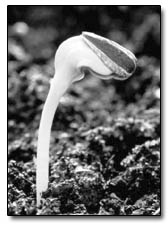
Digging in the dirt
As the staff of
the Telegraph celebrated its first anniversary, a friend approached me, offered
congratulations and asked, "So, what's next? Do you have your eye on the big time?"

For him, the "big time" involved the expansion of our
Durango base, the beginning of similar operations in other towns and eventually the status of
Southwest Colorado media mini-moguls. Briefly my mind flashed on the grandeur of William Randolph
Hearst's San Simeon castle, and for a fleeting moment, I tasted greed. But aided by the realities
of the checkbook ledger, I resurfaced in the real world instantly.
In response to his question, I said there was no immediate
danger of the "big time" and instead related my actual life ambition, quietly answering, "Someday,
I really just want to become a farmer."
Call it strange, I told him, but my highest aspiration is
to someday live off the land and grow things for a living. With a romantic urge, my thoughts
turned back to early March, when Rachael and I first separated the seeds, made selections and
planted starts. For weeks, we scanned the soil for any sign of life and watched awe-struck when
plants like tomatillos and marrow sprang from the soil and stretched their delicate leaves
skyward. Peruvian peppers, relleno chilies, stupice tomatoes all appeared in quick succession,
each bringing a sense of renewal with it. Eventually our sun room was filled with hundreds of tiny
starts, ranging from pumpkins and cucumbers to sweet corn and watermelon. Outside, the snow was
still falling.
As months passed, the promise of the crop became so
enticing that I devoted most of my days off to working the soil and preparing our little farm.
Then, not without warning, the first tragedy struck. Barely 3 inches tall, our cucumber and squash
starts were hammered by a fungus that eventually destroyed them. A couple weeks later, frost hit
and wiped out our apricot blooms. Our apple and peach trees were blighted not long after by insect
larva.
But there was hope. The soil appeared to be in fine shape,
and when we got the remaining starts in the ground in early May, the survivors eased comfortably
into their new environs. Ladybugs and earthworms flocked into the garden and started working their
charms.
For the first time in nearly a decade, we exercised an
experimental urge, abandoning rows and instead planting a mixed community of dozens of types of
greens, along with radishes and carrots. We also underseeded a crop of clover, hoping the short
stems would hold moisture in, keep weeds out and fix nitrogen from the atmosphere and naturally
fertilize our crop.
With corn growing head high, zucchinis the size of my
forearm, an abundant pepper and tomato crop and even some small watermelons surviving, the
experiment appeared to be working. In fact, it was working so well and rainfall was so consistent
that we grew lazy and starting spending days off in the pursuit of leisure. For the last three
weeks, we let nature run the show in the garden.
However, I was shocked back to consciousness recently when
I spotted a hulking, black animal moving through our little farm. Armed only with a work boot, I
leaped up the hillside over the terrace only to stand a few steps away from a good-sized black
bear making a quick meal of several spaghetti squash, plants we'd been nurturing for six months.
Now airborne, the boot got the bear's attention and in seconds he was over our fence and into the
neighbor's property.
It was then that I noticed the true extent of the damage,
and nearly none of it was bear related. Instead, I saw evidence of our three-week vacation.
Bindweed, my least favorite invader, was everywhere and in full bloom. In a few cases, it had
twirled all the way around tomatoes, climbed their full height and started squeezing the life out
of them. The musk thistle we'd spent the prior three months pulling looked unscathed and was
living happily alongside mallow and chickweed. To make matters worse, all of the weeds were
soaking up the benefits of my cover crop and had grown to obscene sizes.
The dream was temporarily dashed, months of hard work were
undone and, consequently, I happily rolled back into my newspaper office the following morning,
content to leave the weeds at home.
But farming was still at the front of my mind a few days
later at that celebration, when my friend uttered these fateful words: "These are sad times when
you have to make your fortune and then start your farm."
I agreed, noting the irony of an age when only the wealthy
can indulge in back-breaking, honest work. In particular, I thought of the one legitimate,
agricultural operation I had worked on in San Miguel County. Several months ago, I drove past the
old ranch to see one 500-acre chunk now subdivided. None of the lots had sold. A little farther
down the road, I spotted the ranch house I'd lived it. It had burned to the ground and only a few
charred remains sat atop the foundation. "Insurance settlement" was the first thing that popped
into my head.
Still it is refreshing to know that the people of Durango
and La Plata County are trying to solve the agriculture riddle and realize a dream of local
growers feeding local people. Hopefully, this weekend's Small Farms Conference will bring some
more answers to the surface. Hopefully, some day local farmers and ranchers will be able to not
merely survive but profit in one of the noblest of all trades.
For my part, I know that there's no danger of me trading
in my pen for a spade in the near future. I've still got way too many bugs to work out in the
broccoli crop.
-Will Sands
|

